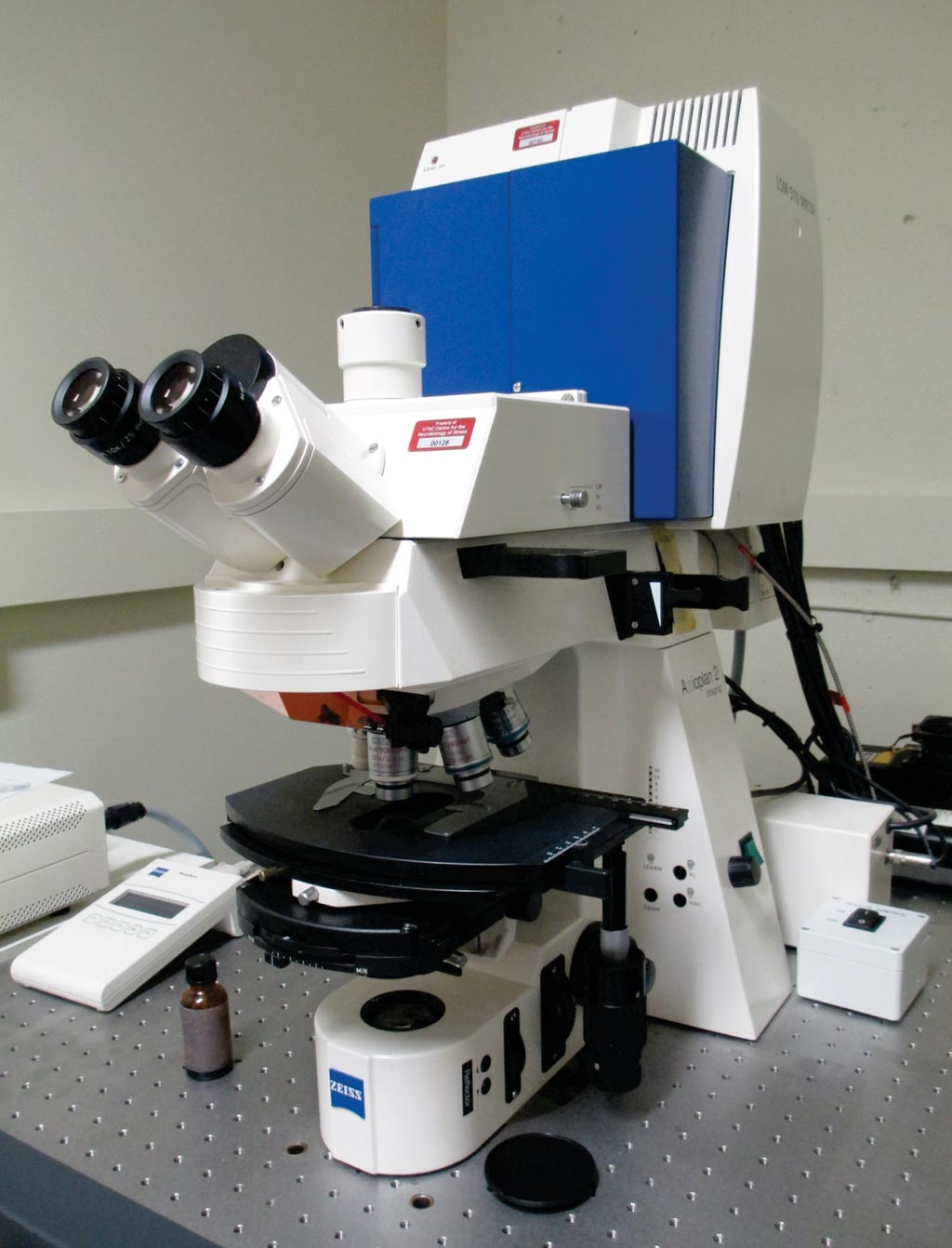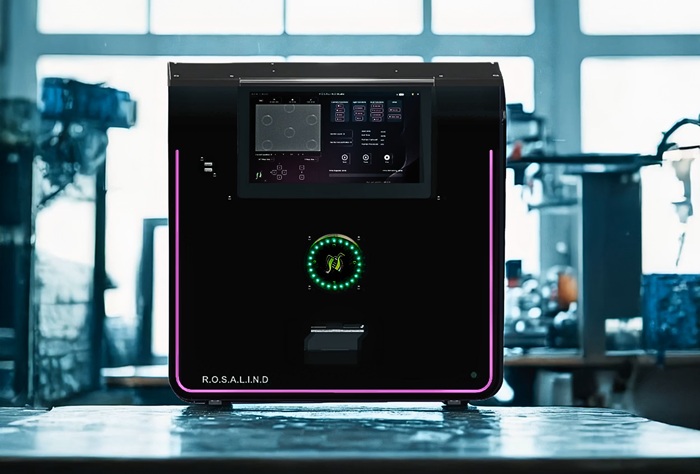Technology Developed for Prostate Cancer Diagnosis and Monitoring
|
By LabMedica International staff writers Posted on 06 Apr 2017 |

Image: The LSM510 META confocal microscope (Photo courtesy of Zeiss).
Early diagnosis of prostate cancer and evaluation of appropriate treatment options requires development of effective and high-throughput selective capture technology for exosomes that are positive for the expression of enzyme-biomarker, prostate-specific membrane antigen (PSMA).
Technology under development will provide a non-invasive approach for diagnosing prostate cancer and tracking the disease's progression and it could enable doctors to determine how cancer patients are responding to different treatments without needing to perform invasive biopsies.
Bioengineers at Washington State University fitted a mat of tiny glass springs with specially designed biomarkers that attract the fatty droplets of proteins and RNA that tumor cells shed into body fluids. The droplets, called exosomes, contain genetic information that can be analyzed to determine a cancer's molecular composition, even how far it has advanced. Exosomes are small secreted vesicles that play a key role in intercellular communication and cancer progression.
PSMA is highly enriched in exosomes excreted by PSMA positive prostate cancer cells. Using PSMA positive cells from the well-established prostate cancer cell line (LNCaP), the secreted exosomes were collected and isolated from the culture medium. The tumor-derived exosomes were selectively captured using a novel silica nanostructure support that had been functionalized with the small molecule ligand TG97, a known inhibitor of PSMA enzymatic activity that binds irreversibly in the active site of PSMA. All samples were incubated at room temperature for 20 minutes, followed by analysis using flow cytometry with a FACS Calibur flow cytometer. The samples were imaged using a 25× 9 water immersion objective with a 510 META confocal microscope.
M. Grant Norton, a professor of mechanical and materials engineering and senior author of the study said, “Say you have a urine sample from a patient known to have prostate cancer. You could pass the urine through the device we are in the process of putting together and measure the number of exosomes that are specifically from prostate cancer cells. The physician would propose a treatment plan and the amount of exosomes in a follow-up urine sample would indicate how effective the treatment was.” The study was published online on February 16, 2017, in the Journal of Materials Science.
Technology under development will provide a non-invasive approach for diagnosing prostate cancer and tracking the disease's progression and it could enable doctors to determine how cancer patients are responding to different treatments without needing to perform invasive biopsies.
Bioengineers at Washington State University fitted a mat of tiny glass springs with specially designed biomarkers that attract the fatty droplets of proteins and RNA that tumor cells shed into body fluids. The droplets, called exosomes, contain genetic information that can be analyzed to determine a cancer's molecular composition, even how far it has advanced. Exosomes are small secreted vesicles that play a key role in intercellular communication and cancer progression.
PSMA is highly enriched in exosomes excreted by PSMA positive prostate cancer cells. Using PSMA positive cells from the well-established prostate cancer cell line (LNCaP), the secreted exosomes were collected and isolated from the culture medium. The tumor-derived exosomes were selectively captured using a novel silica nanostructure support that had been functionalized with the small molecule ligand TG97, a known inhibitor of PSMA enzymatic activity that binds irreversibly in the active site of PSMA. All samples were incubated at room temperature for 20 minutes, followed by analysis using flow cytometry with a FACS Calibur flow cytometer. The samples were imaged using a 25× 9 water immersion objective with a 510 META confocal microscope.
M. Grant Norton, a professor of mechanical and materials engineering and senior author of the study said, “Say you have a urine sample from a patient known to have prostate cancer. You could pass the urine through the device we are in the process of putting together and measure the number of exosomes that are specifically from prostate cancer cells. The physician would propose a treatment plan and the amount of exosomes in a follow-up urine sample would indicate how effective the treatment was.” The study was published online on February 16, 2017, in the Journal of Materials Science.
Latest Pathology News
- Rapid Low-Cost Tests Can Prevent Child Deaths from Contaminated Medicinal Syrups
- Tumor Signals in Saliva and Blood Enable Non-Invasive Monitoring of Head and Neck Cancer
- Common Health Issues Can Influence New Blood Tests for Alzheimer’s Disease
- Blood Test Formula Identifies Chronic Liver Disease Patients with Higher Cancer Risk
- Tunable Cell-Sorting Device Holds Potential for Multiple Biomedical Applications
- AI Tool Outperforms Doctors in Spotting Blood Cell Abnormalities
- AI Tool Rapidly Analyzes Complex Cancer Images for Personalized Treatment
- Diagnostic Technology Performs Rapid Biofluid Analysis Using Single Droplet
- Novel Technology Tracks Hidden Cancer Cells Faster
- AI Tool Improves Breast Cancer Detection
- AI Tool Predicts Treatment Success in Rectal Cancer Patients
- Blood Test and Sputum Analysis Predict Acute COPD Exacerbation
- AI Tool to Transform Skin Cancer Detection with Near-Perfect Accuracy
- Unique Immune Signatures Distinguish Rare Autoimmune Condition from Multiple Sclerosis
- Simple Optical Microscopy Method Reveals Hidden Structures in Remarkable Detail
- Hydrogel-Based Technology Isolates Extracellular Vesicles for Early Disease Diagnosis
Channels
Clinical Chemistry
view channel
POC Breath Diagnostic System to Detect Pneumonia-Causing Pathogens
Pseudomonas aeruginosa is a major cause of hospital-acquired and ventilator-associated pneumonia, particularly in lung transplant recipients and patients with structural lung disease. Its ability to form... Read more
Online Tool Detects Drug Exposure Directly from Patient Samples
Doctors often rely on patient interviews and medical records to determine what medications a person has taken, but this information is frequently incomplete. People may forget drugs they used, take over-the-counter... Read moreMolecular Diagnostics
view channel
Rapid Diagnostic Breakthrough Simultaneously Detects Resistance and Virulence in Klebsiella Pneumoniae
Antibiotic resistance is a steadily escalating threat to global healthcare, making common infections harder to treat and increasing the risk of severe complications. One of the most concerning pathogens... Read more
DNA Detection Platform Enables Real-Time Molecular Detection
A next-gen DNA detection platform enables real-time molecular detection by detecting nucleic acids directly without enzymes or thermocyclers, thereby slashing costs, reducing complexity, and boosting reliability... Read moreHematology
view channel
MRD Tests Could Predict Survival in Leukemia Patients
Acute myeloid leukemia is an aggressive blood cancer that disrupts normal blood cell production and often relapses even after intensive treatment. Clinicians currently lack early, reliable markers to predict... Read more
Platelet Activity Blood Test in Middle Age Could Identify Early Alzheimer’s Risk
Early detection of Alzheimer’s disease remains one of the biggest unmet needs in neurology, particularly because the biological changes underlying the disorder begin decades before memory symptoms appear.... Read more
Microvesicles Measurement Could Detect Vascular Injury in Sickle Cell Disease Patients
Assessing disease severity in sickle cell disease (SCD) remains challenging, especially when trying to predict hemolysis, vascular injury, and risk of complications such as vaso-occlusive crises.... Read more
ADLM’s New Coagulation Testing Guidance to Improve Care for Patients on Blood Thinners
Direct oral anticoagulants (DOACs) are one of the most common types of blood thinners. Patients take them to prevent a host of complications that could arise from blood clotting, including stroke, deep... Read moreImmunology
view channel
Blood Test Could Identify Colon Cancer Patients to Benefit from NSAIDs
Colon cancer remains a major cause of cancer-related illness, with many patients facing relapse even after surgery and chemotherapy. Up to 40% of people with stage III disease experience recurrence, highlighting... Read moreBlood Test Could Detect Adverse Immunotherapy Effects
Immune checkpoint inhibitors have transformed cancer treatment, but they can also trigger serious immune-related adverse events that damage healthy organs and may become life-threatening if not detected early.... Read moreMicrobiology
view channel
Breakthroughs in Microbial Analysis to Enhance Disease Prediction
Microorganisms shape human health, ecosystems, and the planet’s climate, yet identifying them and understanding how they are related remains a major scientific challenge. Even with modern DNA sequencing,... Read more
Blood-Based Diagnostic Method Could Identify Pediatric LRTIs
Lower-respiratory tract infections (LRTIs) are a leading cause of illness and death worldwide, and pneumonia is the leading infectious cause of death in children under five, claiming the lives of over... Read moreTechnology
view channel
Machine Learning Models Diagnose ALS Earlier Through Blood Biomarkers
Amyotrophic lateral sclerosis (ALS) is a rapidly progressive neurodegenerative disease that is notoriously difficult to diagnose in its early stages. Early symptoms often overlap with other neurological... Read more
Artificial Intelligence Model Could Accelerate Rare Disease Diagnosis
Identifying which genetic variants actually cause disease remains one of the biggest challenges in genomic medicine. Each person carries tens of thousands of DNA changes, yet only a few meaningfully alter... Read moreIndustry
view channel
BD and Penn Institute Collaborate to Advance Immunotherapy through Flow Cytometry
BD (Becton, Dickinson and Company, Franklin Lakes, NJ, USA) has entered into a strategic collaboration with the Institute for Immunology and Immune Health (I3H, Philadelphia, PA, USA) at the University... Read more






















